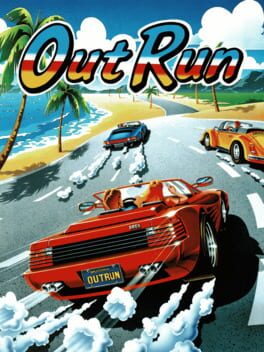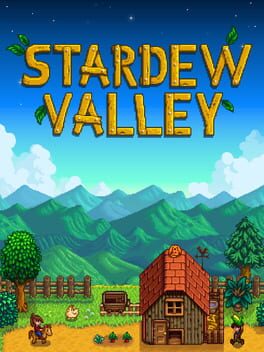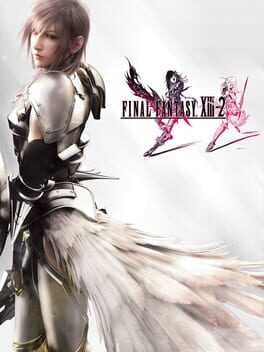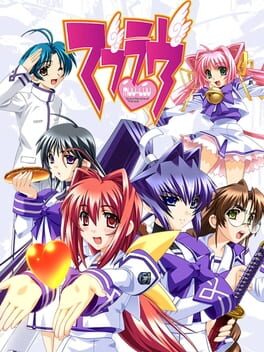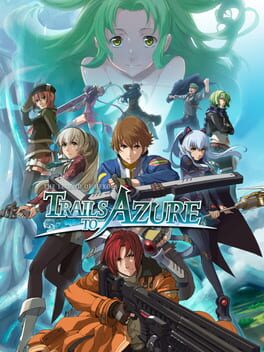Vilani
11 reviews liked by Vilani
Within the game's gorgeous open zones, windows of interaction with different manners of moving through the maps (using a stream of wind to get up a platform, using a fire skill to burn down vines, etc.) are often gatekept by a varied set of abilities acquired by leveling up certain attributes in favour of specific openings in the game's Affinity trees (which are unique for each Blade) --- the so called field skills are only but one of the many variables that rule how Blades you bond with will interact with traversal, combat and overall progression through the game. There is a notable contrast between the sprawling, natural and detailed zones of the setting and the slippery, awkward character movimentation through these same panoramas filled with markers and cluttering UI identifiers; an incongruity between the maximalist, megalomaniac numerical obsession of the matters in which players connect and interact with that virtual world, and the often terrain-based combat/navigation that constantly demands that you look around and look for gaps between the pixelated topography, to check if there's an unrelated enemy around who could aggro you and interrupt your chain of orbs, to topple a flying enemy and make it fall down after you make it to higher ground, to use rails, rocks or other common environment assets to cheese your way through battles by gaining distance from the enemy's aggroing and auto-attacking with a bitball or a cannon while their path is blocked by said asset, to make use of the game's many position-based Arts: these strategies are not exceptions, but constant thoughts and visualizations I had through the game's many, many encounters.
This friction between the 'artificial' and the 'pulsing', the 'constant' and the 'drifting', is what builds this game's main dialectics: in this made-up world of flamboyant designs destined to be made fun of or utilized for their visual and questionable appeal, of series of integers and technical rigidness bounding the player to a progression based on variables and array-based requirements, how do we achieve genuine connection between constructs that seem to attract inherent unseriousness and confusion? How do we break down the walls of 'artifices' between the player and the game? The answer could only be one: Rex, and his Salvager Code.
The panache and naivete of juvenile optimism, the shonen-esque confidence in all that exists and the resolve to make people smile. Within the bounds of its own artificiality and the signifiers used to construct its experience, Xenoblade Chronicles 2 somehow manages to weave a convincing force of sincerity through a world that is conducted by the forces of constants, arrays, dipping frames and uncertain dynamic resolution --- all of that which cannot be organically touched or interacted with, ends up crossing the walls of mechanicality unexplainably by the end of it all, finding expression and meaning in the most unexpected places. A boy and a girl make a promise to reach Paradise; the boy complies without knowing why, not even because of the fact she saved his life right beforehand --- for giving his life for a stranger is simply his spirit. A girl who fears her own power, shutting herself off for unspecified milennia; a boy who finds treasures in junk for a living, salvaging meaning and memories out of seamless clouds. In the friendship between Rex and Pneuma lies the game's final and most important dichotomy, the impossibility between eternity and remembrance, the way in which our selves are tied to our egos which are formed by the promises we make to each other, how one would rather die than be forgotten by the one they love and keep on going for infinity. Theirs is a relationship of light: uncertainness about oneself's purpose breed spontaneity and trust in that which shines the way forward. Shin had Metsu, Hana had Hikari; within the endless streams of lights we project when we break down the walls of artifices between us, we find identity and purpose.
In each of the game's varied landscapes, one sight tends to repeat itself: the view of Alrest's enormous World Tree, the promised spot that gives access to Paradise and God, peering at his creations above the sea of white. To find that these organic leaves sprouting from its head and that the wooden exterior of its large shell house a high-tech facility full of elevators and robot guards only intensifies the images that Alrest creates through gameplay: an ocean hiding before humanity's ruins in Morytha, the vistas of the clouds forming different shapes and patterns within the perspectives of each character, numerical catharsis and exploitation of the artifices as a means of visualizing the act of bonding and the struggle of moving forward by your own means. Connecting Arts and auto-attacks indefinitely, building up elemental spheres and breaking them with the collective power of strategized synchrony; the endless QTEs building up in the screen demanding timing and linking in this fascinating real-time turn-based system.
"I love this world because you're in it."
This friction between the 'artificial' and the 'pulsing', the 'constant' and the 'drifting', is what builds this game's main dialectics: in this made-up world of flamboyant designs destined to be made fun of or utilized for their visual and questionable appeal, of series of integers and technical rigidness bounding the player to a progression based on variables and array-based requirements, how do we achieve genuine connection between constructs that seem to attract inherent unseriousness and confusion? How do we break down the walls of 'artifices' between the player and the game? The answer could only be one: Rex, and his Salvager Code.
The panache and naivete of juvenile optimism, the shonen-esque confidence in all that exists and the resolve to make people smile. Within the bounds of its own artificiality and the signifiers used to construct its experience, Xenoblade Chronicles 2 somehow manages to weave a convincing force of sincerity through a world that is conducted by the forces of constants, arrays, dipping frames and uncertain dynamic resolution --- all of that which cannot be organically touched or interacted with, ends up crossing the walls of mechanicality unexplainably by the end of it all, finding expression and meaning in the most unexpected places. A boy and a girl make a promise to reach Paradise; the boy complies without knowing why, not even because of the fact she saved his life right beforehand --- for giving his life for a stranger is simply his spirit. A girl who fears her own power, shutting herself off for unspecified milennia; a boy who finds treasures in junk for a living, salvaging meaning and memories out of seamless clouds. In the friendship between Rex and Pneuma lies the game's final and most important dichotomy, the impossibility between eternity and remembrance, the way in which our selves are tied to our egos which are formed by the promises we make to each other, how one would rather die than be forgotten by the one they love and keep on going for infinity. Theirs is a relationship of light: uncertainness about oneself's purpose breed spontaneity and trust in that which shines the way forward. Shin had Metsu, Hana had Hikari; within the endless streams of lights we project when we break down the walls of artifices between us, we find identity and purpose.
In each of the game's varied landscapes, one sight tends to repeat itself: the view of Alrest's enormous World Tree, the promised spot that gives access to Paradise and God, peering at his creations above the sea of white. To find that these organic leaves sprouting from its head and that the wooden exterior of its large shell house a high-tech facility full of elevators and robot guards only intensifies the images that Alrest creates through gameplay: an ocean hiding before humanity's ruins in Morytha, the vistas of the clouds forming different shapes and patterns within the perspectives of each character, numerical catharsis and exploitation of the artifices as a means of visualizing the act of bonding and the struggle of moving forward by your own means. Connecting Arts and auto-attacks indefinitely, building up elemental spheres and breaking them with the collective power of strategized synchrony; the endless QTEs building up in the screen demanding timing and linking in this fascinating real-time turn-based system.
"I love this world because you're in it."
OutRun
1986
The image of what a car represents to me changed continuously ever since I was a child. Playing with miniature vehicles felt magical not because I enjoyed the idea of driving one itself (the roaring of the engine and the complexities seen by my infant eyes in the act of turning and parking made me dread their physical form) but rather for the feeling that the spacial possibilities of their inherently small and inconsequential formats were fundamentally richer than their 'real life' counterparts, not being bound by any of the stiffness that comes with the rigid set of rules required to stipulate safety in traffic. Trying to see whether I could or could not manage to propel a bootleg Hotwheels toy to speed all the way from the kitchen to the entrance door without losing the coolness of its unstability and invencibility amidst the environment it ventured itself across was an almost primal, reflexive pleasure to dwell in throughout my childhood. That being said, just like the naive idealizations and images of life come and go without any sort of warning or consolation, the embellished picturing of that car I used to believe in so fiercely drove away from me very early on - as I became progressively ashamed to play with toys in a silly, childish struggle to create a more mature image of myself. Not because I wanted to be an adult, but because I wanted to be taken seriously by grown-ups and groups of friends alike, a naturally stubborn feeling that a lot of people might have had when they were kids. In the span of one night and countless visions, I'd lost that world I could call mine without even acknowledging it until many years later.
Deadly accidents, the unbearable stress of roundabouts and the idea of having to pay attention to multiple factors at once constituted my idea of speed, transportation, and most of all, vehicles. Speed in particular always bothered me. The rampant, cutting breeze slashing across my cheeks while my body felt so vulnerable due to the absence of inertia made me uneasy rather than excited when being driven around in a motorbike. The quickly changing nature of matter while in this state of velocity reminded me of the consequences of its possible sudden halt - crashings. In such a way I've seen happening around me and to people that I knew, the image of the car, the motorcyle, the speed and the traveling, were all perceived in my own eyes as symbols of death. I could no longer remember or even picture the joy of moving, of acting, of unpredictability and of the changing vistas remaining subservient to the stillness of the horizon even in their own seemingly never-ending implants of mirages on the sides of our eyes, burning in the realm of the subconscious. Outrun and its sucessor, Outrun 2 did not magically suck me in on its dreamscape of diegetic sounds and silly animations of bumping your car max speed on an outdoor and violently being thrown away only to come back unscathed in half a second on a first play, but God, did it eventually make me believe in it and love it as if I was a kid playing with car toys again for the first time.
First of all, there's almost no congruence between Yu Suzuki's visualization of the car and my own childish ideals about its inconsequential nature inside whatever world it ventured across - acceleration and impact could storm through any surface or background, whereas in Outrun the image of the vehicle is bound to the road and to the idea of an eternity beneath the horizon's ephemerality, consistently being attached to an infinite, pixelated diorama of the sky that morphs between moods seamlessly yet constructs the game's own very characteristic feeling throughout - excitement. The tilitating anxiety of grasping another world beyond the ticking clock that urges us to attain the next checkpoint, the demanding nature of wanting to impress your loved one with the speed that brings divinity to the showcase of those rapidly moving pictures, the slightly trembling hands as you realize you're almost finishing a run for the first time. To present us with all of these feelings, the antithesis of movement is brought upon as turns - which require you to understand the drift as a mechanic and think about the most optimal way of drifting without losing speed, and to maintain that speed while also not crashing. Its 'easy to learn, hard to master' arcade construct makes it easier for players to constantly look for better times on stages, making Outrun become this sort of comfortable space where one can dream and believe in nothing but moving forward - there are no cars to unlock, no new songs, no skins, just the wonder of discovering new landscapes and of feeling how they move beneath the blue sky. I can only imagine how much more tense the experience must've been while playing in actual arcade machines; depending on your money or on how crowded the arcade was, you only had a few opportunities to play it before somewhere else got their chance. In that regard Outrun also understands and exhales its own excitement outside of the pixel display, as an object of shared attention it is incredibly satisfactory to see someone else play it and beat it for a first time - much like the girlfriend exhibits that anticipation and expectation towards the player's performance (even making requests in Outrun 2's heart mode), there is a sunset-colored romance in the idea of sharing the joy of runnning through these roads only picturing the next view you'll see, the next gasp of surprise someone will exclaim to try to cheer you up, the idea of leaving everything else behind. For the short bursts in which I play whichever Outrun game, Yu Suzuki's Ferrari Testarossa Spider drives into my heart and completely blinds me with his own vision of driving, of seeing, of not letting the road bumps scare you and of consistently challenging you to see more each time you boot it up, of the physicality of those images burning away at the sound of Splash Wave along with my own worries. It awakens desires of sensations I constantly rejected, longing of places I've never been and of objects I'd almost always dreaded.
The game over screen of these games always stood out to me. A short bit of melancholy as the palm trees darken and the sun goes down, a calm and slightly sad song telling you "goodbye, you're always welcome here.", a powerful contrast to the otherwise constant excitement the game portrays in every corner of its universe. The horizon too has an end, just like the feelings of riding across exhilarating sceneries and of feeling loved are uninterruptedly moving and transforming through different meanings and pictures without us even realizing it. Outrun is a dreamy reminder of the worlds I could immerse myself upon as a child, and a statement that it is impossible to talk about videogames without dreaming through our ideal realities.
Deadly accidents, the unbearable stress of roundabouts and the idea of having to pay attention to multiple factors at once constituted my idea of speed, transportation, and most of all, vehicles. Speed in particular always bothered me. The rampant, cutting breeze slashing across my cheeks while my body felt so vulnerable due to the absence of inertia made me uneasy rather than excited when being driven around in a motorbike. The quickly changing nature of matter while in this state of velocity reminded me of the consequences of its possible sudden halt - crashings. In such a way I've seen happening around me and to people that I knew, the image of the car, the motorcyle, the speed and the traveling, were all perceived in my own eyes as symbols of death. I could no longer remember or even picture the joy of moving, of acting, of unpredictability and of the changing vistas remaining subservient to the stillness of the horizon even in their own seemingly never-ending implants of mirages on the sides of our eyes, burning in the realm of the subconscious. Outrun and its sucessor, Outrun 2 did not magically suck me in on its dreamscape of diegetic sounds and silly animations of bumping your car max speed on an outdoor and violently being thrown away only to come back unscathed in half a second on a first play, but God, did it eventually make me believe in it and love it as if I was a kid playing with car toys again for the first time.
First of all, there's almost no congruence between Yu Suzuki's visualization of the car and my own childish ideals about its inconsequential nature inside whatever world it ventured across - acceleration and impact could storm through any surface or background, whereas in Outrun the image of the vehicle is bound to the road and to the idea of an eternity beneath the horizon's ephemerality, consistently being attached to an infinite, pixelated diorama of the sky that morphs between moods seamlessly yet constructs the game's own very characteristic feeling throughout - excitement. The tilitating anxiety of grasping another world beyond the ticking clock that urges us to attain the next checkpoint, the demanding nature of wanting to impress your loved one with the speed that brings divinity to the showcase of those rapidly moving pictures, the slightly trembling hands as you realize you're almost finishing a run for the first time. To present us with all of these feelings, the antithesis of movement is brought upon as turns - which require you to understand the drift as a mechanic and think about the most optimal way of drifting without losing speed, and to maintain that speed while also not crashing. Its 'easy to learn, hard to master' arcade construct makes it easier for players to constantly look for better times on stages, making Outrun become this sort of comfortable space where one can dream and believe in nothing but moving forward - there are no cars to unlock, no new songs, no skins, just the wonder of discovering new landscapes and of feeling how they move beneath the blue sky. I can only imagine how much more tense the experience must've been while playing in actual arcade machines; depending on your money or on how crowded the arcade was, you only had a few opportunities to play it before somewhere else got their chance. In that regard Outrun also understands and exhales its own excitement outside of the pixel display, as an object of shared attention it is incredibly satisfactory to see someone else play it and beat it for a first time - much like the girlfriend exhibits that anticipation and expectation towards the player's performance (even making requests in Outrun 2's heart mode), there is a sunset-colored romance in the idea of sharing the joy of runnning through these roads only picturing the next view you'll see, the next gasp of surprise someone will exclaim to try to cheer you up, the idea of leaving everything else behind. For the short bursts in which I play whichever Outrun game, Yu Suzuki's Ferrari Testarossa Spider drives into my heart and completely blinds me with his own vision of driving, of seeing, of not letting the road bumps scare you and of consistently challenging you to see more each time you boot it up, of the physicality of those images burning away at the sound of Splash Wave along with my own worries. It awakens desires of sensations I constantly rejected, longing of places I've never been and of objects I'd almost always dreaded.
The game over screen of these games always stood out to me. A short bit of melancholy as the palm trees darken and the sun goes down, a calm and slightly sad song telling you "goodbye, you're always welcome here.", a powerful contrast to the otherwise constant excitement the game portrays in every corner of its universe. The horizon too has an end, just like the feelings of riding across exhilarating sceneries and of feeling loved are uninterruptedly moving and transforming through different meanings and pictures without us even realizing it. Outrun is a dreamy reminder of the worlds I could immerse myself upon as a child, and a statement that it is impossible to talk about videogames without dreaming through our ideal realities.
Stardew Valley
2016
Persona 3 FES
2007
This is probably my favorite JRPG ever made, though I have a lot of bias bc of when it came into my life and its specific subject matter. Really important game, and I think it's a must-play if you're somebody who dwells on mortality and the Meaning of Life (tm) a lot, though it might hit the hardest if you are in fact in (or concluding) high school when you first experience it.

